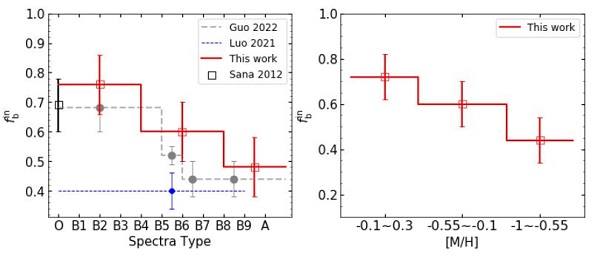Ph.D. candidate GUO Yanjun from Yunnan Observatories of the Chinese Academy of Sciences (CAS) and her collaborators reported a recent work on the study of the intrinsic binary fraction of massive stars from the LAMOST DR8. The researchers utilized the Medium Resolution Spectra (MRS) database to collect optical spectra of 886 early-type stars, each with more than six observations.
The researchers investigated the dependency of the intrinsic binary fraction on the derived stellar effective temperature, metallicity and projected rotational velocity. This work was published in Astronomy & Astrophysics on November 4.
Early-type stars with spectral classification span from O-type to A-type are massive, with high effective temperatures. They contribute to the universe's re-ionization and may enrich metallicity in the galactic environment. Most early-type stars are found in binary systems, and they likely evolve to compact binary systems, such as double black holes, double neutron stars, or neutron star and black hole binaries. Statistical properties of early-type massive stars, such as intrinsic binary fraction, distribution of orbital period and mass ratio, are often used as essential inputs for binary population synthesis models and are important tracers to investigate stellar formation. However, many past works on this subject are often limited by a small sample of observations or inconsistent data collected from various sources. These lead to significant uncertainties for derived statistical properties for the population.
Motivated by the extensive collection of optical spectra from the LAMOST DR8 MRS, the researchers obtained observations for 886 early-type stars from the database, and each target star has more than six spectra. Based on the derived stellar effective temperature, metallicity, and projected rotational velocity, the researchers have divided the sample into sub-groups. Radial Velocity measurements of each target star were collected from a prior study by Guo et al. (2021), and a set of Monte Carlo simulations were applied to the measurements to correct any potential observational biases in the sample.
The researchers found that the intrinsic binary fraction in the sample displays an increasing trend toward a population with a higher effective temperature. The binary fraction can reach up to ~76% for O- and B-type stars while dropping to 48% for B- and A-type stars. A similar trend was found in the relationship between the intrinsic binary fraction and metallicity, in which the ratio achieves ~72% for metal-rich stars and degrades to 44% for metal-poor stars in the sample. These results will be further applied to evolutionary models to constrain massive binaries' formation process and provide insights into compact binary formation scenarios.
Contact:
GUO Yanjun
Yunnan Observatories, CAS
Email: guoyanjun@ynao.ac.cn

Fig1: The dependency of the intrinsic binary fraction derived from a sample of 886 early-type stars from the LAMOST DR8 MRS database (red) on the spectral type is shown in the left panel. Results of such binary fractions obtained from prior studies are also plotted in the figure for comparison. Our result is consistent with prior works, indicating a decreasing trend of the binary fraction towards the later spectral type. The intrinsic binary fraction displays a decreasing trend towards metal-poor stars (right panel).